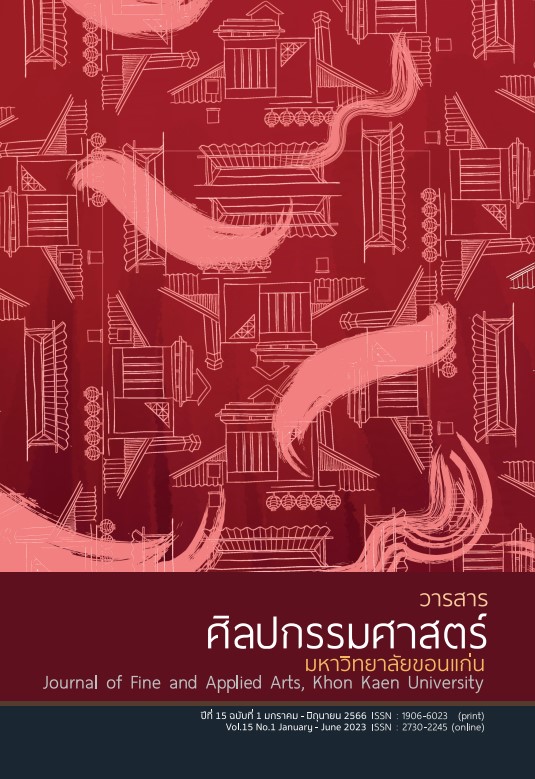Playing Techniques on Saw Duang and Haegeum Fiddles: Similarities and Differences
Main Article Content
Abstract
The research of Playing Techniques on Saw Duang and Haegeum Fiddles: similarities and differences has three purposes, firstly, to study the physical characteristics and the practice of Saw Duang and Haegeum, secondly, to study strategies in playing Saw Duang and Haegeum and lastly, to study the similarities and differences of Saw Duang and Haegeum. The researcher has studied data from the fieldwork and analyzed them by using a qualitative research methodology.
The study results show that there are 10 Physical and Practical Characteristics of Saw Duang and Haegeum, three practices. Saw Duang and Haegeum playing Techniques can be divided into ensemble and solo. Similarities and differences between their physical characteristics are different of Rad-ok and bow tension. Saw Duang must be pressed the string with the fingertips and controlled the bow fit while Haegeum must be pressed the strings with a second finger joint. The ring finger and little finger have two sound positions. Haegeum uses more weight to control has more dynamics.
The left-hand techniques share four techniques which are: 1.Prom pid is like Three of nonghyeon. 2.Changing finger position on Haegeum's Ulim and Nelim. 3.“Tod New” 4.“Kratop Siang” matches the two-sound pressing with the middle finger. The differences of Saw Duang are found in 4 techniques: Prom perd, finger rolling, dapping, and rubbing. Haegum has two techniques: Twesong and ornamental ( ). The right-hand techniques share 10 likeness There are two specific Saw Duang techniques: Yoy Jangwa and Sa Euk bow. Haegeum's characteristics include six techniques which are about controlling the mood of the song.
Article Details

This work is licensed under a Creative Commons Attribution-NonCommercial-NoDerivatives 4.0 International License.
Content and information in articles published in the Journal of Fine and Applied Arts of Khon Kaen University is regarded as the opinion and sole responsibility of the author(s) directly; therefore, editors are not obliged to agree to or share any responsibility with regard to the content and information that appears within these articles.
All articles, information, content, image, etc. that have been published in the Journal of Fine and Applied Arts of Khon Kaen University is the copyright of the Journal of Fine and Appllied Arts of Khon Kaen University. Any person or organization who wishes to distribute all or parts of the articles for further dissemination or other usage must first receive permission from the Journal of Fine and Applied Arts of Khon Kaen University before proceeding to do so.
References
ชาคริต เฉลิมสุข. (2552). วิเคราะห์เดี่ยวจะเข้เพลงพญาฝัน พญาโศก พญาครวญ สามชั้น ทางรองศาสตราจารย์ปกรณ์ รอดช้างเผื่อน. วิทยานิพนธ์ปริญญาศิลปศาสตรมหาบัณฑิต สาขาดุริยางค์ไทย บัณฑิตวิทยาลัย จุฬาลงกรณ์มหาวิทยาลัย.
ธรณัส หินอ่อน. (2561). เดี่ยวซอด้วง. ขอนแก่น : โครงการผลิตหนังสือและตำราด้านดุริยางคศิลป์และศิลปะการแสดง คณะศิลปกรรมศาสตร์ มหาวิทยาลัยขอนแก่น.
สำนักมาตรฐานอุดมศึกษา สำนักงานปลัดทบวงมหาวิทยาลัย. (2544). เกณฑ์มาตรฐานดนตรีไทยและเกณฑ์การประเมิน. กรุงเทพฯ : ภาพพิมพ์.
Korean Traditional Performing Arts Foundation. (2011). Haegeum two string fiddle encounters with Korean traditional music. Seoul: Ministry of Culture, Sports and Tourism.
Lee, D. H. (2007). Research on rhythm patterns in Ji Yeonghee type Haegum Sanjo. Korea: Chung-Ang University.
The National Center for Korean Traditional Performing Arts. (2009a). Korean musicology series 1: Music of Korea. Seoul: National Center for Korean Traditional Performing Arts.
The National Center for Korean Traditional Performing Arts. (2009b). Korean musicology series 3: Sanjo. Seoul: Wonwha DNP.


